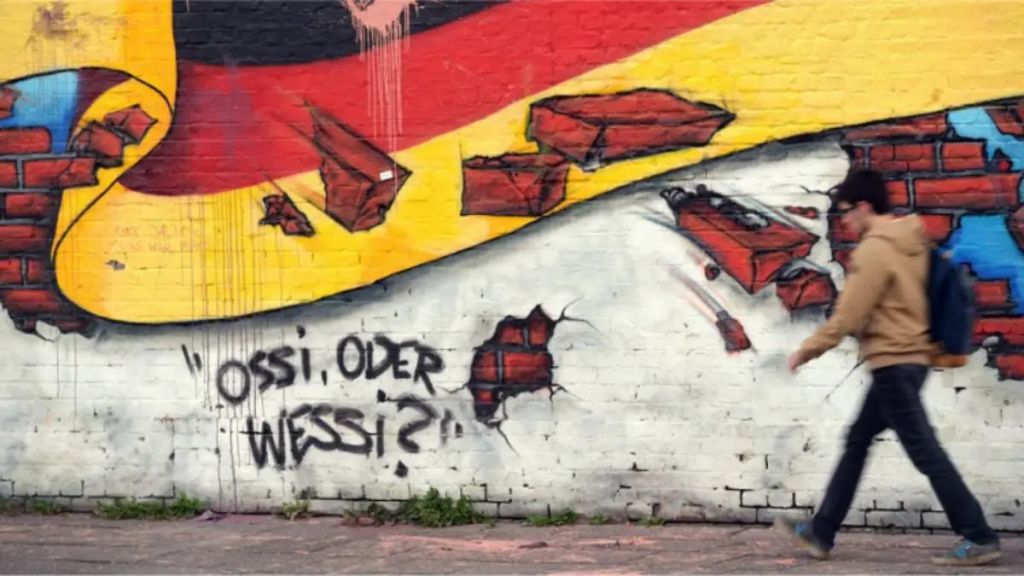What is the matter with East Germany?
There is also a progressive view on East-Germany. It emerges from the context of the so-called “new Eastern debate,” underway since the 1990s. And yet, the very idea that there “is” an East-Germany might well be a West-German invention.
At the same time, there are undeniable facts – such as the now deeply structural underrepresentation of East-Germans in positions of influence, both in East-Germany and even more so in the West.
In other words: Germany’s administrative, military, economic, political, and cultural elites are West-German – not East-German.

Posted by Thomas Klikauer
Much has been written about East-Germany — most of it, not too flattering. After all, East-Germany is the promised land of the neo-fascist AfD. Germany’s neo-Nazi party is more than twice as strong in the East as it is in the West.
Yet, it is not all dark and grim in Dunkeldeutschland — that dark, backward, reactionary, and, in parts, outright neo-Nazi version of East Germany.
There is also a progressive view on East-Germany. It emerges from the context of the so-called “new Eastern debate,” underway since the 1990s. And yet, the very idea that there “is” an East-Germany might well be a West-German invention.
At the same time, there are undeniable facts – such as the now deeply structural underrepresentation of East-Germans in positions of influence, both in East-Germany and even more so in the West.
In other words: Germany’s administrative, military, economic, political, and cultural elites are West-German – not East-German.
It is even worse in the media sector, where East-Germans are virtually invisible. This alone creates a distorted image: West-Germany is overrepresented – East Germany, underrepresented.
The same can be said about ownership. The West owns. The East does not. And power relations reflect that. West Germans – the Wessies (worse: Besseewessies) – dominate, even in the East.
The failure of West-Germany – more than that of the East – has helped construct a West German narrative about a supposed regional “mood” in East Germany. That mood, however, is not necessarily shared by East-Germans themselves.
Given the arrogance of the West-German Anschluss of the East, what remains is a widespread feeling of disappointment and frustration – in the West and the East, albeit for vastly different reasons.
Much of this connects to a widespread consciousness where affects and knowledge coexist in contradiction – side by side.
Worse still is the well-known marginalization experienced by many East-Germans. More cruel is their erasure from political-economic and socio-psychological analyses of the so-called “East.”
The result is a prevailing image: East Germany as a peripheral sub-society within Europe’s economic powerhouse. This peripheralization was fuelled by the massive reorganization of ownership in the 1990s.
After capitalism took control of formerly state-owned means of production, vast parts of the land and urban real estate were transferred to West-German private and corporate owners. The numbers tell the story:
- 85% of East-Germany’s means of production were handed to West-German companies.
- 10% went to international companies.
- A minuscule 5% remained in East-German hands.
A bloodletting far worse than what the victorious Soviet Union demanded after liberating Germany from Nazism in 1945.
This Western takeover created property relations that have proven extremely stable to this day, thanks to Germany’s inheritance system and capital concentration – designed by West-Germany.
A local corporate bourgeoisie – desired by segments of the East-German population and its political elites – barely exists. The West’s seizure was total.
Because of these one-sided ownership structures, East-Germany has depended on continuous public transfers since 1990. Even profits from rental income and wind turbines flow back to Western owners. A cunning system that makes West-Germany rich – and East-Germany poor.
The idea of a “self-supporting” East — prescribed by Wessies for Ossies – was a cruel joke. It added insult to injury.
Moreover, west-to-east state transfers – ostensibly designed to compensate for the structural weaknesses of East-German municipalities – in fact represent a redistribution from the bottom (public tax money) to the top (owners). Worse still: much of it flows back to the West in the form of rent payments for apartments now owned by Wessies, for example.
Meanwhile, East-Germany has become a zone of externalization, with production and even profitable manufacturing outsourced to its territory.
Recent ventures like the now-cancelled Intel chip factory in Magdeburg and Tesla’s Giga Factory in Brandenburg have used East-Germany as a testing ground for geopolitical strategies.
These corporations benefit from weak civil society, which often results in lower environmental standards, lower wages, fewer unions, and a lower cost of living– all subsidized by Germany’s public infrastructure.
This allows us to understand East Germany as a geographic zone of peripheral capitalism.
Peripheral capitalism describes the structural dependence between economic peripheries (East Germany) and Western metropolises and monopolies (West Germany).
In this top-down hierarchy, East Germany functions as a geographical investment sphere for certain segments of capital. It occurs when even East-Germany’s low wages can’t sustain profitability, and outsourcing becomes unattractive elsewhere.
Even more than a labour reservoir, the periphery is exploited as a market. Dependency becomes a structural principle, defining many East-German regions plagued by economic decline.
What makes East-German democracy so fragile is that virtually all major economic and social processes are decided externally – in the West. Local democratic control is absent.
This alienates people. The neo-fascist AfD exploits this alienation by stripping capitalism from the equation and inserting racism in its place.
Worse, East-German cities are increasingly dependent on state-controlled resource allocations – with political decisions made elsewhere.
Labour disputes in East-Germany often feel, from the perspective of wage earners, like “negotiating with ghosts.” Corporate decision-makers sit in distant headquarters in West-Germany.
The denial of participation in such conflicts – while suffering the consequences – has become part of East-Germany’s collective memory. It led to blocked biographies, unemployment, and poverty. Social mobility remains low. Advancement chances are slim. Participation is limited.
And yet, it is not only dependency that is the structural principle — but also the transfers themselves, which exacerbate dependency.
Without public transfers, East-Germany has virtually no independent economic performance. These funds are essential to sustaining a minimum standard of living and maintaining public infrastructure.
Since the 1990s, transfers have served to pacify a fragile East-German society – even during the baseball bat years of rampant neo-Nazi violence. These years were followed by the NSU, and later, the rise of the AfD.
The East-West relationship is riddled with contradictory “cohesion forces” – structural dependence on one side, and care on the other. These opposing dynamics have only worsened the social imbalance between East- and West-Germany.
West German arrogance is amplified by a narcissistic sense of being denied full participation in their own prosperity. Perhaps it is because of all this that an authoritarian dynamic has been growing in East-Germany since the 1990s.
The ideological drift towards neo-Nazism among many East-Germans – nearly one-third now vote for the AfD – is a direct result of this complex web of dependency on West-Germany and its elites.
Feelings of external control, political powerlessness, and being denied a fair share – of being short-changed – are spreading, particularly among East Germany’s younger generation.
But this discontent need not have taken an authoritarian turn. It required the propaganda machinery of the AfD to redirect economic resentment away from capitalism and towards two invented enemies: the Western elite and migrants.
This created a dual channel for action: either acting within existing power structures, or pursuing a generalized expansion of power. On the whole, East-Germany’s Neo-Nazis have chosen the latter.
Many East-Germans have expressed this through mob-like rallies and demonstrations that demand exclusion of “the Other,” or by electing AfD apparatchiks in a self-styled act of “defence” against “the system” – i.e., the West.
Underlying much of this is a desire for re-unification – but not “under” the West. Rather, a restoration of old patriarchal, masculine, chauvinistic, nationalist, and racist privileges.
The AfD capitalizes on this dispossession – Hillary Clinton’s “deplorables” – offering an authoritarian home based on Ostalgie: a nationalist fantasy, a hollowed-out homecoming for those who fit the hallucination of an Aryan, inward-looking, reactionary – and ultimately inbred – Volks-Community.
Photo: (source: German government (https://www.bpb.de/themen/deutschlandarchiv/316541/wie-man-zum-ossi-wird-nachwendekinder-zwischen-klischee-und-stillschweigen/)
Subscribe to Cross-border Talks’ YouTube channel! Follow the project’s Facebook and Twitter page! And here are the podcast’s Telegram channel and its Substack newsletter!
Like our work? Donate to Cross-Border Talks or buy us a coffee!










